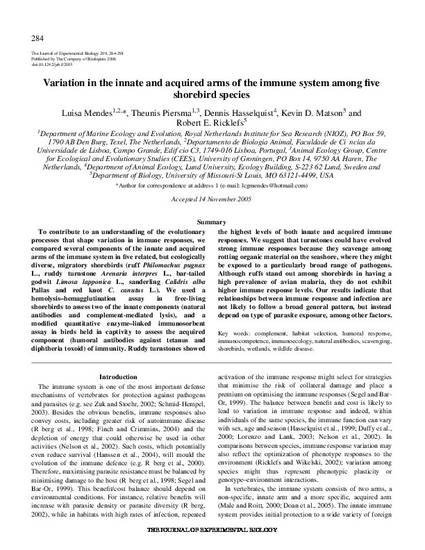
Article
Variation in the Innate and Acquired Arms of the Immune System Among Five Shorebird Species
The Journal of Experimental Biology
(2006)
Abstract
To contribute to an understanding of the evolutionary processes that shape variation in immune responses, we compared several components of the innate and acquired arms of the immune system in five related, but ecologically diverse, migratory shorebirds (ruff Philomachus pugnax L., ruddy turnstone Arenaria interpres L., bar-tailed godwit Limosa lapponica L., sanderling Calidris alba Pallas and red knotC. canutus L.). We used a hemolysis-hemagglutination assay in free-living shorebirds to assess two of the innate components (natural antibodies and complement-mediated lysis), and a modified quantitative enzyme-linked immunosorbent assay in birds held in captivity to assess the acquired component (humoral antibodies against tetanus and diphtheria toxoid) of immunity. Ruddy turnstones showed the highest levels of both innate and acquired immune responses. We suggest that turnstones could have evolved strong immune responses because they scavenge among rotting organic material on the seashore, where they might be exposed to a particularly broad range of pathogens. Although ruffs stand out among shorebirds in having a high prevalence of avian malaria, they do not exhibit higher immune response levels. Our results indicate that relationships between immune response and infection are not likely to follow a broad general pattern, but instead depend on type of parasite exposure, among other factors.
Disciplines
Publication Date
January 15, 2006
DOI
10.1242/jeb.02015
Citation Information
Luisa Mendes, Theunis Piersma, Dennis Hasselquist, Kevin D. Matson, et al.. "Variation in the Innate and Acquired Arms of the Immune System Among Five Shorebird Species" The Journal of Experimental Biology Vol. 209 Iss. 2 (2006) p. 284 - 291 Available at: http://works.bepress.com/robert-ricklefs/175/
